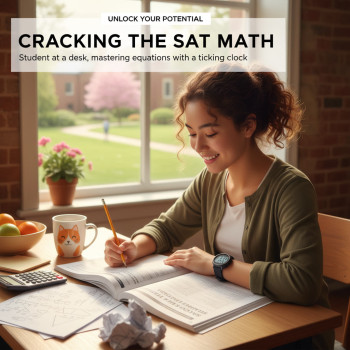Why Your SAT Practice Test Scores Jump Around (And What to Do About It)
One week you ace a practice test and feel invincible. The next, you end up nearly a hundred points lower and start questioning everything — your preparation, your study plan, maybe even your aptitude. If that sounds familiar, take a breath: score swings are normal, surprisingly common, and fixable.
Let’s start with the obvious question: are score fluctuations normal?
Yes. Practice test scores for the SAT often fluctuate, sometimes dramatically. The test has many moving parts: a mix of content areas, time pressure, reading passages of varying difficulty, and an element of randomness in which specific skills are tested on any single test. Add the human variables — sleep, stress, nutrition, the testing environment — and you have a recipe for variability.
What causes SAT practice scores to change — the short list
Below are the main categories that explain most score swings. Each deserves attention because understanding the cause is the first step toward steady improvement.
- Test form variability: Not every practice test is created equal. Some are slightly harder or easier in certain sections.
- Preparation quality vs. quantity: Random drilling can inflate short-term scores without lasting learning.
- Test conditions and timing: Even small changes in timing or environment can nudge scores up or down.
- Psychological factors: Stress, confidence, and mindset impact performance.
- Scoring noise and guessing: A handful of different answers can change scaled scores noticeably.
- Fatigue and physical state: Sleep, food, and hydration matter more than many students realize.
Test form variability: the hidden reason
Imagine two practice tests. Both are labeled “full-length,” but one includes denser reading passages and a handful of geometry questions you’ve never practiced; the other favors algebra and short, straightforward passages. Even a well-prepared student can score differently across these forms because the skill mix has shifted.
Practice-test publishers aim to standardize difficulty, but variations persist. These are real and meaningful. When you see a score swing, check whether the composition of skills tested changed — that may explain more than your study quality.
Preparation quality vs. quantity
Doing a dozen practice tests in a month can make you familiar with the format. But without focused review, you might be repeating the same mistakes. Quantity without quality leads to noisy improvements: practice can temporarily raise scores through pattern recognition and short-term memory, while underlying skill gaps remain.
Think of it like training for a sport. Running sprints might improve conditioning quickly, but if your running stride is inefficient you’ll hit a plateau. The SAT is similar — drill the wrong habits and you’ll see inconsistent results.
Test conditions and timing
Small differences in how you take a practice test matter. Did you take it at 9 a.m. with a full breakfast or late at night after school? Were your breaks timed like the real test? Did you use scratch paper? Sitting at a desk with a timer produces a different outcome than sprawled on a couch with a phone nearby.
- Treat practice tests like the real thing: same timing, same breaks, no phone, and a quiet space.
- Simulate the start-of-day routine so your body and mind learn the rhythm of a test day.
Psychological factors: mindset, confidence, and stress
Your brain is the engine of performance. Anxiety tightens it; confidence loosens it. A few wrong answers early in a section can cascade: you start to second-guess, you lose time, and mistakes multiply. Conversely, a strong start can boost focus and carry you through harder questions.
Practicing stress-management techniques — deep breathing, short mindfulness exercises, and a simple warm-up routine — helps create emotional resilience. Over time, consistent practice under simulated stress reduces score volatility.
Scoring noise and guessing
On the SAT, a missed question can have a surprisingly large effect on scaled scores, especially when you’re on a certain part of the conversion curve between raw scores and scaled scores. That means a few questions either way can shift your score by dozens of points.
Random guessing can inflate or deflate raw scores. Learning when to guess and when to spend the time to reason is a practical skill that stabilizes performance.
Fatigue, nutrition, and physical state
Sleep matters. A single poor night’s sleep impairs attention, processing speed, and memory recall — all essential for the SAT. Dehydration and low blood sugar are also performance killers. Students often underestimate how physical needs shape cognitive outcomes.
Real examples: score fluctuations you might recognize
Here are three fictional but realistic cases to illustrate how different factors produce different kinds of score swings.
- Case A — The test-taker with uneven content exposure: Sam scores 1220 on a practice test heavy in algebra, then 1100 on a test with more geometry and sentence-improvement questions he hasn’t practiced. The swing reflects knowledge gaps, not motivation.
- Case B — The tired consistent studier: Priya usually scores around 1350, but after a week of AP exams and late nights she drops to 1250. Her skills are intact; her physical state isn’t.
- Case C — The confidence roller-coaster: Miguel starts a test confident, misses a few near the beginning, becomes anxious, and his speed and accuracy decline. A 90-point drop follows even though his content knowledge is similar.
One table that makes the point
| Practice Test | Raw Evidence (Reading/Writing) | Raw Math | Total Scaled Score | Likely Cause of Change |
|---|---|---|---|---|
| Test 1 (Baseline) | 42/52 | 38/58 | 1260 | Standard |
| Test 2 (Harder passages) | 36/52 | 40/58 | 1210 | Form variability |
| Test 3 (Late night) | 35/52 | 33/58 | 1170 | Fatigue / focus |
| Test 4 (Focused review) | 44/52 | 42/58 | 1310 | Targeted prep |
This simplified table shows how different factors — difficulty of passages, physical state, and targeted practice — can each push your score in distinct directions.
How to interpret fluctuations wisely (and avoid panic)
When you see a low score, don’t panic. Instead, treat scores as signals. Good interpretation uses patterns, not single data points. Follow these practical steps:
- Track multiple tests across time: Aim for a trend of at least 4–6 full-length tests to understand trajectory.
- Analyze section-by-section, not just total score: You’ll often find that one section is the main source of variability.
- Look for repeating question types you miss: If you miss similar questions across tests, that’s a specific weakness to target.
- Record context: Note time of day, sleep, and interruptions. Patterns often emerge when you account for these factors.
Why one-off scores lie (and what to trust instead)
A single practice test can be misleading. While a strong test suggests potential, a weak test can be an outlier. Trust multi-test averages and consistent improvement in targeted skills. For example, if your average across four tests climbs from 1120 to 1200, that improvement is meaningful even if you had one bad day in the middle.
Practical strategies to reduce score volatility
Steady improvement isn’t magic — it’s method. Here are concrete, actionable strategies that students can use immediately.
1) Make practice realistic and consistent
- Schedule full-length tests at the same time of day you’ll sit the real SAT.
- Use a strict timing protocol and replicate the break structure.
- Simulate test conditions: clear desk, quiet room, no phone.
2) Prioritize targeted review over random practice
When you miss a problem, spend time understanding why you missed it. Create an error log that tracks: question type, the mistake, the correct approach, and the rule or concept to review. Over time, patterns emerge and you can focus study where it matters.
3) Build stamina gradually
The SAT is a marathon of focus. Practice building mental stamina with longer study sessions that mirror the test’s length. Start with shorter blocks and gradually increase them; don’t jump from 30-minute sessions to a full 3-hour practice overnight.
4) Train your test day routine
Create a ritual: sleep schedule, breakfast choices, time you arrive at your desk, short warm-up. Consistency reduces friction and knocks down variables that cause score swings.
5) Manage stress and maintain physical health
- Prioritize sleep in the week before a test.
- Stay hydrated and eat balanced meals; include protein and low-glycemic carbs before a practice test.
- Practice brief mindfulness or breathing exercises to keep nerves in check.
6) Use a balanced mix of question practice and concept review
It’s tempting to only do full tests, but micro-targeted practice (20–40 focused questions on geometry or comma usage) helps you fix specific weak spots without burning out. Alternate between full tests and focused drills in your schedule.
How personalized tutoring and technology help stabilize scores
Targeted guidance accelerates the process of turning noisy test results into a clear improvement plan. Personalized tutoring — whether 1-on-1 sessions with a skilled instructor or a program that tailors study plans — helps you identify root causes of variability and apply fixes efficiently.
Sparkl’s personalized tutoring, for example, offers one-on-one guidance and tailored study plans that focus on the exact skills you’re missing. Expert tutors can interpret your practice test data, emphasize high-yield concepts, and support test-day strategy. In addition, AI-driven insights can quickly flag patterns in mistakes and suggest practice sequences that maximize progress. When you combine human coaching with smart data-driven feedback, you reduce guesswork and make score gains more consistent.
How a tutor helps on specific points
- Interpreting score patterns: Tutors can tell whether a low verbal score is comprehension-based or vocabulary/grammar-based.
- Technique coaching: Timing strategies, guessing heuristics, and how to prioritize questions.
- Motivation and accountability: Regular check-ins keep practice consistent and meaningful.
How to build a 6-week plan to reduce fluctuations (sample)
Here’s a sample short-term plan designed to reduce volatility and produce reliable improvement over six weeks. Adapt it based on your starting score and schedule.
- Week 1: Diagnostic full-length test and comprehensive error log. Identify top three weak areas.
- Week 2: Targeted concept work for those top weaknesses; two timed sections per day plus one full-length test at the weekend.
- Week 3: Continue targeted work; introduce pacing drills and timed passage sets for Reading/Writing.
- Week 4: Full-length test under simulated test-day conditions; evaluate changes and adjust targets.
- Week 5: Deep review of persistent mistakes; focus sessions with a tutor or study partner to remedy logic errors and timing problems.
- Week 6: Two full-length tests spaced apart, final strategy drills, and test-day routine rehearsal.
During each week, keep an error log and note sleep, nutrition, and stress levels on test days. Small, consistent changes compound quickly.
Final thoughts: treat fluctuation as feedback, not failure
Score swings feel personal, but they’re mostly about variables — some you can control, some you can’t. Your job is to control as many as possible: study smart, simulate test conditions, sleep well, and analyze results carefully. When you do that, random noise turns into reliable signals for growth.

Remember: consistent improvement beats occasional brilliance. If you find the noise overwhelming, consider guided help. Sparkl’s personalized tutoring can provide 1-on-1 support, tailored study plans, and focused feedback — all of which reduce uncertainty and speed up progress. Expert tutors paired with AI-driven insights hone in on patterns in your mistakes so every practice test teaches you something tangible.
A short checklist to stabilize your next practice test
- Sleep at least 7–8 hours the night before.
- Take the test at the same time you plan for the real SAT.
- Follow a warm-up routine (light reading, a quick math warm-up, breathing).
- Use an error log for every missed question and review it immediately after each test.
- Mix full-length tests with focused drills and concept reviews.
- Consider occasional tutoring sessions to refine strategy and diagnose persistent issues.

Score fluctuations are not a verdict on your ability. They’re a roadmap. Read them carefully, act deliberately, and you’ll be surprised how quickly a noisy pattern becomes a clear path to the score you want.
Go take your next practice test — and bring the checklist
Walk into that next practice session armed with a routine, an error-log, and a calm mindset. Treat each score as data, not destiny. Keep a steady pace, review deliberately, and seek help when patterns persist. With the right approach, those erratic swings become smaller and less frequent — and your real score will show the difference.



















No Comments
Leave a comment Cancel